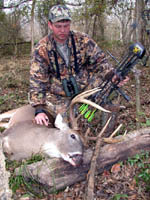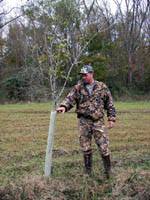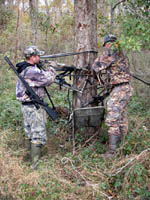
|
Features
|
|
|
|
Books
|
|
|
|
Fun & Games
|
|
|
|
Contact Us
|
|
|
John's Journal... Entry 179, Day 3
GILES ISLAND
Planting on Giles Island
 EDITOR'S
NOTE: Jimmy Riley is the lodge manager and hunt
master for Giles Island, an island in the Mississippi River near Natchez,
Mississippi, and Ferriday, Louisiana. He constantly learns more and more
about the bucks on this island each season, and his management program
has proven success.
EDITOR'S
NOTE: Jimmy Riley is the lodge manager and hunt
master for Giles Island, an island in the Mississippi River near Natchez,
Mississippi, and Ferriday, Louisiana. He constantly learns more and more
about the bucks on this island each season, and his management program
has proven success.
Question: What're you doing for the deer? What're you
planting?
Answer: We plant 150 acres of fall/winter food plots that we incorporate
into our summer plots in the form of oceola clover, which lasts until
August. A tree-planting program is dual-purpose -- wildlife and timber
value. We plant the green ash in the low-lying areas, where oak trees
won't grow, for timber value. We plant the oak tree on the rest of the
area to increase the wildlife value. We plant live oaks in the sandy areas.
They have a long maturity, but our grandkids may get to see them. We plant
red oak, water oak and sawtooth in various places. We've planted a few
white oak on the higher-elevated places where the flood may not affect
them. We've also planted cypress in a few areas.
 Question:
You've planted fruit trees, right?
Question:
You've planted fruit trees, right?
Answer: We've planted a few pear trees, apple trees and peach trees just
to play with them and to see what works. A few have survived, but they
usually don't do too well because of the island's sandy soil.
Question: Most areas along the Mississippi depend on
oak nuts to feed their deer, but you use pecans.
Answer: Yeah. We have a slave levee that extends from the Mississippi
River, where the cutoff was made in 1933, all the way back around to the
airport across the island. We call it a slave levee because the slaves
built it -- not to keep water in or out, but to give access to the island.
Most of the antebellum homes in Natchez are made with cypress and oak.
And since there aren't many cypress and oak on the island, we think they
were depleted back in the antebellum days. As a result, the sweet pecan
has taken over as one of the dominant species on the island. The most-dominant
tree in board feet is cottonwood, and the second most-dominant is sweet
pecan. The pecans are full of carbohydrates and fat, and the deer eat
them like popcorn.
 Question:
What's the difference in sweet pecans and regular pecans?
Question:
What's the difference in sweet pecans and regular pecans?
Answer: None. That's a sweet pecan. They may grow bigger. They're all
sweet pecans, and they taste great. Ours are a little smaller than average
because they're wild.
Question: How did the pecans get here?
Answer: It's natural. They're native. You'll see them all up and down
the river islands. We think all our cypress and oaks were logged-out to
build homes.
To learn more about Giles Island, write 461 Old River Boat Camp Road, Ferriday, LA 71334, call (877) 944-5374, or visit www.gilesisland.com.
TOMORROW: GILES ISLAND DEER MANAGMENT
Check back each day this week for more about GILES ISLAND ...
Day 1 - Dream Bucks on Giles
Island
Day 2 - The History of Giles Island
Day 3 - Planting on Giles Island
Day 4 - Giles Island Deer Management
Day 5 - Being A Deer Guide on Giles Island